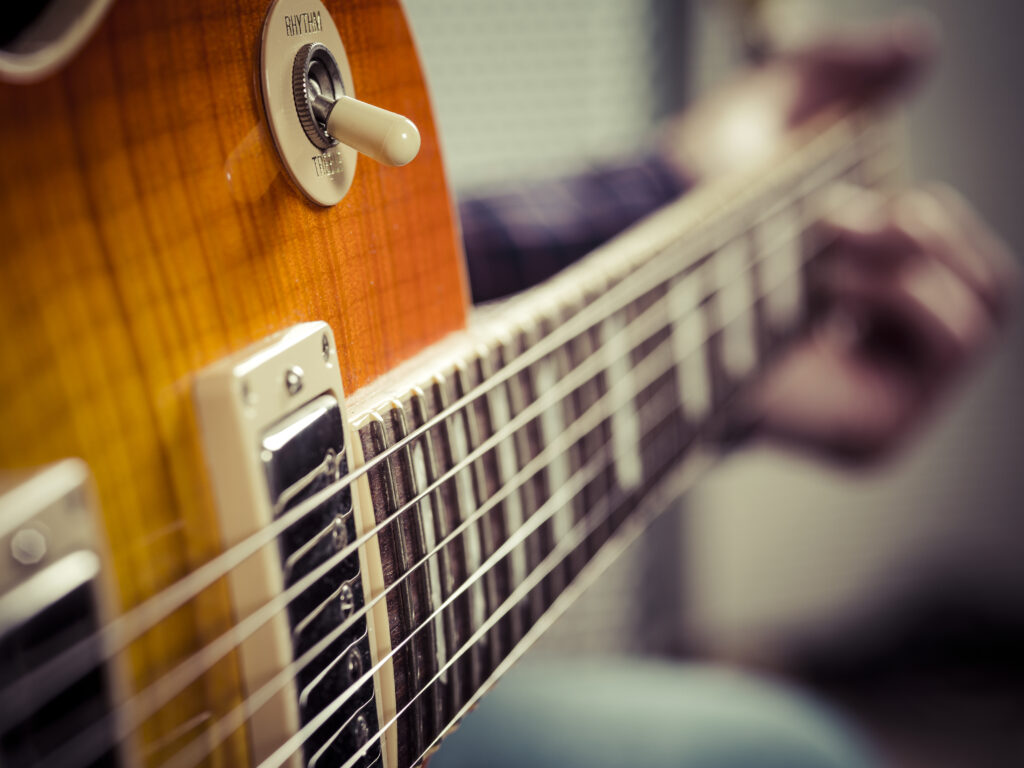
Today, we embark on a thrilling journey to discover the top 10 most expensive guitars sold at auction. These iconic guitars have commanded record-breaking prices, with a combined worth exceeding £27.5 million.
In the last four years, three different guitars have successively broken the record for the most expensive guitar.
These guitars have inspired legendary artists, sometimes more than one, to create genre-defining pieces of music. They are cultural icons that have graced timeless music and resonated with the souls of millions.
Each guitar on this illustrious list has provided unforgettable performances and groundbreaking compositions, from the mesmerizing melodies of Pink Floyd to the raw power of Nirvana.
Join us as we explore the top 10 most expensive guitars sold at auction. We’ll be shedding light on their awe-inspiring histories, the legendary artists who wielded them and what gives them their extraordinary value.
Skip Ahead
#10 – David Gilmour’s 1954 Fender Stratocaster
#9 – Jerry Garcia’s Wolf Guitar
#8 – Peter Green’s “Greeny” Les Paul
#7 – Jimi Hendrix’s “Izabella” 1968 Fender Stratocaster
#6 – John Lennon’s Gibson J-160E
#5 – Reach Out to Asia Fender Stratocaster
#4 – Eddie Van Halen’s “Hot For Teacher” Kramer
#3 – David Gilmour’s Black Strat
#2 – Kurt Cobain’s “Teen Spirit” Fender Mustang
#1 – Kurt Cobain’s 1959 Martin D-18E
#10 – David Gilmour’s 1954 Fender Stratocaster (£1.49 million)
At #10 on our list of the top 10 most expensive guitars sold at auction is the 1954 White Fender Stratocaster. David Gilmour, of Pink Floyd fame, previously owned this stunning Stratocaster, which his fans know as the #0001 Strat.
In June 2019, this guitar fetched £1,493,000 at a Christie’s auction in New York, far exceeding the estimated price. It briefly held the record for the most expensive Fender ever sold.
Like everything in that auction, this guitar’s proceeds went to climate change charity, ClientEarth. This grand gesture of parting with his one-of-a-kind and prestigious guitars is a testament to David Gilmour’s commitment to combatting climate change.
The First Strat Ever Made?
Guitarists highly regard David Gilmour for his use of Fender Stratocasters. This 1954 White Fender Stratocaster, numbered #0001, is one of the Strats most associated with David Gilmour.
Despite its #0001 serial number, this Stratocaster is not the first of its kind. Its unusual colour and gold hardware suggest that it was a showpiece, potentially crafted for a special occasion or as a gift for an employee.
A subtle white finish adorns the ash body of the #0001 Strat. In various lighting conditions, the guitar’s finish can appear aged Olympic White, pale green, or even a hint of blue.
Complete with an anodized gold pickguard, custom gold plated tremolo system and Kluson Deluxe tuners, this is a truly stunning Strat.
Changing Hands
The guitar’s origins add to its allure. Leo Fender initially owned this guitar before it found its way into the hands of Seymour Duncan. In the mid-70s, Seymour Duncan sold the guitar to Phil Taylor, who served as David Gilmour’s long-time guitar technician. Gilmour got his hands on the guitar around 1976-77. Taylor had asked Gilmour for a loan to buy a house. As a condition for receiving the loan, Phil Taylor sold the Strat to Gilmour.
Cementing The Wall
The #0001 Strat made its debut in the live promo clips for Gilmour’s first solo album in 1978. It later played a key role in the creation of Pink Floyd’s The Wall. It provided the crisp rhythm guitar for the classic Pink Floyd track “Another Brick in the Wall (Part 2)”. To achieve this tone, they directly plugged the #0001 Strat into the mixing desk.
This Strat also featured on Paul McCartney’s Back to the Egg album and the song “So Glad to See You Here”. This Strat even appeared in the video for Bryan Ferry’s “Is Your Love Strong Enough”.
The Strat Pack
The #0001 Stratocaster’s crowning moment came during the celebration of the Stratocaster’s 50th anniversary in 2004, The Strat Pack.
Gilmour played three songs at London’s Wembley Arena, two of which featured the #0001 Stratocaster. One of the songs was a rare performance of “Marooned” from the album The Division Bell.
Jump Back To The Top
Alternatives to the #0001 Stratocaster
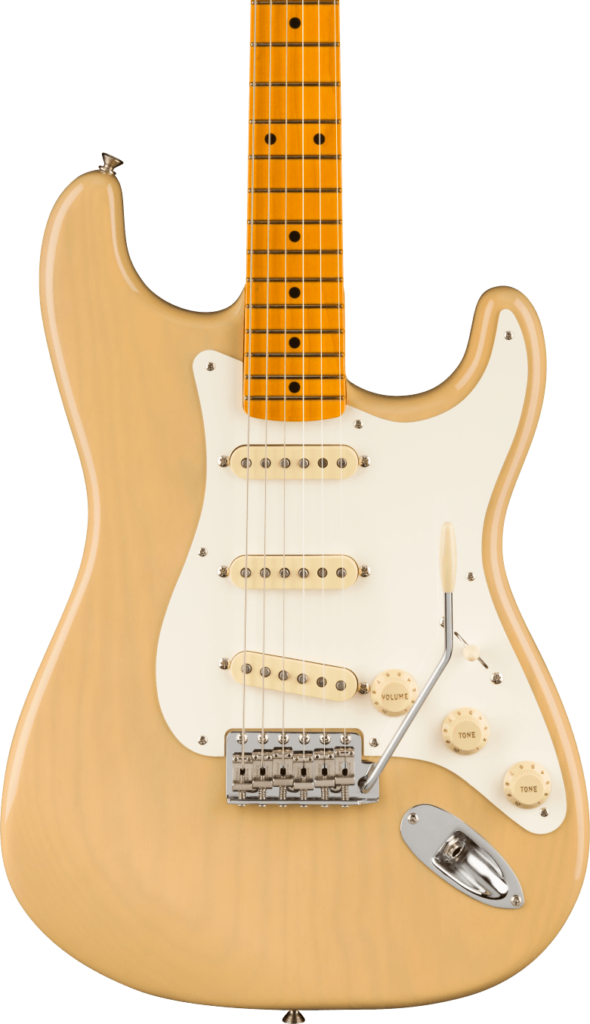
Fender American Vintage II 1957 Stratocaster, Vintage Blonde
Although the Fender American Vintage II 1957 Stratocaster is based on a model that came out a few years after the #0001, it nails that sought-after ’50s Fender feel and tone. Plus, it’s significantly more affordable than a vintage Fender!
The Vintage Blonde-finished version is closest in spec and looks to the #0001 out of the three 1957 models, as it features an Ash body. Replacing the white pickguard with an anodized gold one will bring you much closer to the original’s look.
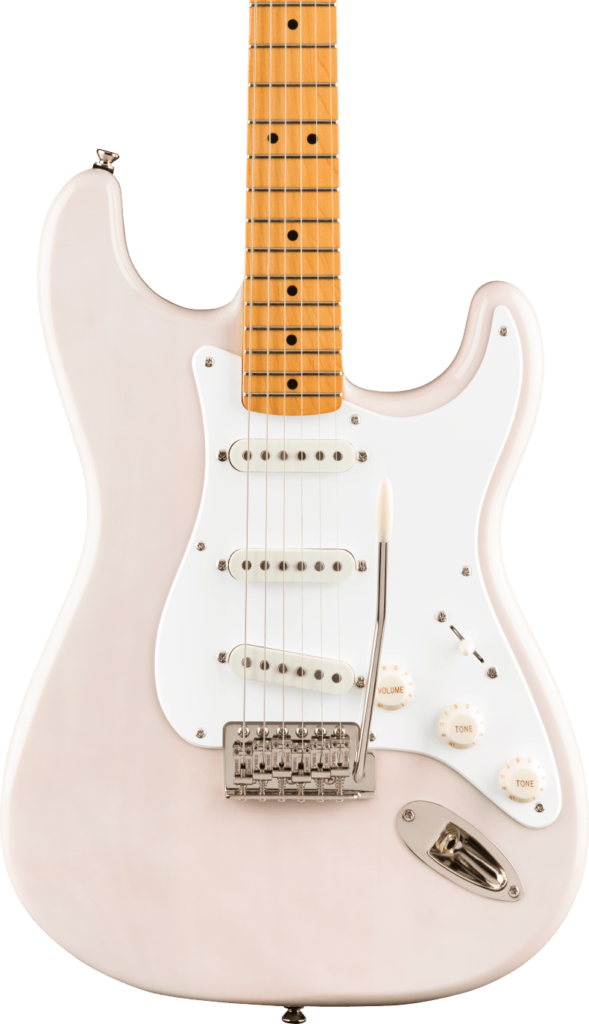
Squier Classic Vibe ’50s Stratocaster, Maple, White Blonde
The Squier Classic Vibe ’50s Stratocaster is a superb electric guitar at an affordable price point. This Squier Strat features Fender-designed alnico pickups and ’50s-inspired headstock markings for that Golden Era aesthetic.
By replacing the pickguard with an anodized gold version, you can recreate the #0001 Stratocaster at a price that won’t break the bank.
Jump Back To The Top
#9 – Jerry Garcia’s Wolf Guitar (£1.57 million)
At #9 on our list of the top 10 most expensive guitars sold at auction is Jerry Garcia’s Wolf Guitar. Luthier Doug Irwin crafted this exceptional guitar, which made its debut in the hands of the Grateful Dead frontman during a memorable concert for the Hell’s Angels in 1973.
In June 2017, the Wolf Guitar found its new owner in New York, fetching an impressive price of £1,570,000. The sale of the Wolf Guitar in June 2017 resulted in a generous donation to the Southern Poverty Law Center, a that charity dedicates itself to promoting civil rights and pursuing public interest litigation.
A Unique Design
Fans of the Grateful Dead are familiar with the distinctive Wolf, one of Jerry Garcia’s earliest and most recognizable instruments. Crafted by Doug Irwin, a former Alembic luthier, at Garcia’s request in the early seventies, the Wolf became a crucial part of the Grateful Dead’s sound.
It was Garcia’s first custom-made guitar, featuring an asymmetrical original neck-through-body design, a body made of purpleheart and curly western maple. Irwin later inlaid the playful cartoon image of a Wolf, originally a sticker added by Garcia, into the guitar’s design.
After a brief assessment and a few minutes of playing time, Garcia felt an immediate connection with the Wolf. This would lead to Garcia commissioning more custom guitars from Irwin.
Golden Years of the Dead
The Wolf made its stage debut at a private Hell’s Angels party in 1973. This marked the beginning of its prominent presence in the Grateful Dead’s performances during their golden years in the 1970s. The Wolf made many appearances with the Dead until its last performance in 1993 at the Oakland Coliseum.
Craftsmanship and Vision
This distinctive guitar and its role in the early stages of Jerry Garcia’s career have made the Wolf one of the most cherished guitars of all time. The balance, the choice of woods, the neck-through design, and the unique electronics make this guitar a testament to the luthier’s art and the musician’s vision.
The design and performance of the Wolf became the catalyst for Garcia’s enduring relationship with Irwin and his other custom guitars.
Unconventional Tonewoods
The guitar’s body consists of purpleheart, laminated with thin sheets of maple and purpleheart. Bookmatched curly western maple comprises the top and back of the guitar.
The guitar’s neck runs through the body and features a 24-fret Gaboon ebony fingerboard. The fingerboard features African ivory inlays, with the exception of the first fret, which is mother-of-pearl.
Moving With The Times
Initially, the configuration of the Wolf consisted of three Fender Stratocaster pickups. However, the design allowed for experimentation and changes as pickup technology evolved.
The guitar endured several falls during the Grateful Dead’s European tour, which resulted in minor damage. This also prompted a refinishing and the addition of the iconic Wolf inlay.
Jump Back To The Top
#8 – Peter Green’s Greeny (£1.65 million)
At #8 on our list of the top 10 most expensive guitars sold at auction is one of the most prized Les Pauls in the world – “Greeny”. Peter Green, the Fleetwood Mac legend, first owned this 1959 Gibson Les Paul Standard. It would feature on classics like “The Green Manalishi (With the Two Prong Crown)” and “Albatross”.
In 2006, Phil Winfield purchased the guitar from Moore and eventually sold it to a private collector for £1,650,000.
Kirk Hammett is currently the guitar’s proud owner and has given it a new lease of life as one of his stage guitars. You can hear it in action first-hand if you catch Metallica live.
From Fleetwood Mac to Metallica
The “Greeny” Les Paul, a legendary Gibson guitar with a lineage of notable owners, has an incredible story.
This legendary Gibson Les Paul is anything but ordinary. A sought-after 1959 model, “Greeny” is a legend in the world of Gibson guitars, having graced the hands of three bona fide guitar legends.
Unique Les Paul Tone
British Blues icon and Fleetwood Mac founding member Peter Green first purchased the ’59 Les Paul during his time with John Mayall’s Bluesbreakers. Its unique sound, created by a factory error of a wrongly fitted neck pickup, defined the early Fleetwood Mac sound.
The out-of-phase middle position is reminiscent of a Stratocaster, with a biting “quack” that easily cuts through a mix. Gibson’s Les Paul Classic and Les Paul Modern models recreate this tone via a push-pull switch that reverses the phase of the neck pickup.
From Blues to Rock
When Peter Green’s mental health took a toll on his musical career in the ’70s, he loaned the guitar to a promising young musician named Gary Moore. Moore later bought it for the same amount Green had initially paid, ensuring that the guitar would remain in worthy hands.
From Moore’s solo debut in 1973, through his tenure with Thin Lizzy, to his solo hit “Parisienne Walkways,” the “Greeny” Les Paul remained at his side and sounded phenomenal in his hands.
Touring The World
However, in 2006, Moore had to part ways with the beloved guitar due to financial constraints. After selling it for an amount ranging between $750,000 and $1.2 million, the guitar fell into the private collector’s circuit for several years.
It found a new home in 2014 with Kirk Hammett, who acquired it from a private collector. Hammett, overawed by the guitar’s rich history and the opportunity to own an instrument played by Peter Green and Gary Moore, quickly seized the chance.
Here’s Hammett himself describing how Greeny came into his possession:
“It’d been on the market for a few years, but the price was just way too high. And then I kind of waltzed into a situation where the owner of the guitar needed money.”
“And of course, I totally took advantage of the situation, worked out a deal and bought it, all within an hour’s time, because I was so friggin’ blown away by the fact that I was holding a guitar that Peter Green played in Fleetwood Mac and then Gary Moore played for, like, 25 years after.”
Jump Back To The Top
Alternatives to “Greeny”
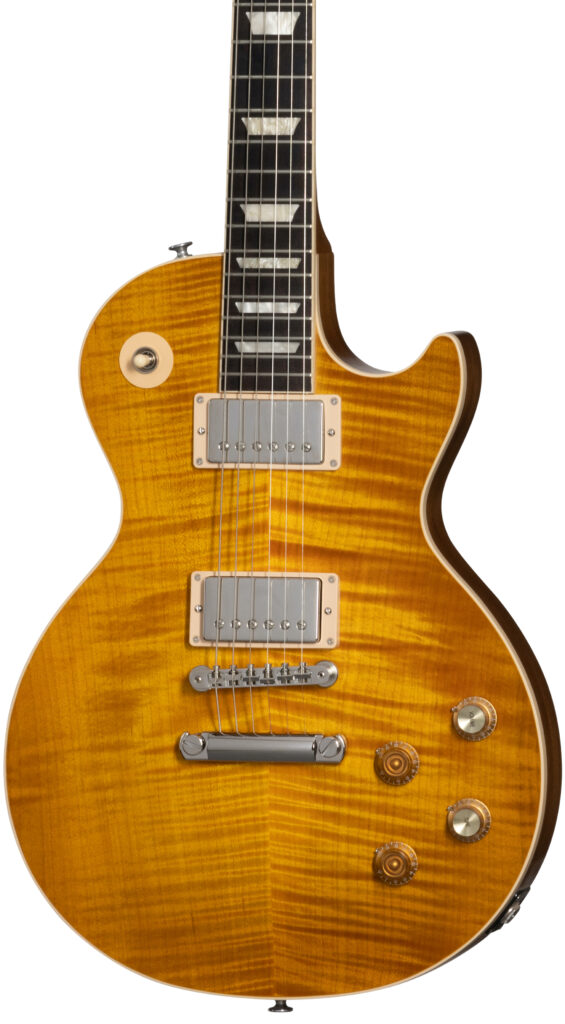
Gibson Kirk Hammett “Greeny” Les Paul Standard, Greeny Burst
Aside from the Gibson Custom Shop Murphy Lab version (or an actual ’59 Les Paul), this guitar is the closest you can get to the real deal.
The Gibson Kirk Hammett “Greeny” Les Paul Standard in Greeny Burst features the same specs and appointments as the original, including the gorgeous “lemon drop” finish, AAA flame maple top and mismatched knobs.
Gibson equips the Kirk Hammett “Greeny” Les Paul Standard with two Greenybuckers. Like the original, the neck pickup features a reverse-mounted configuration with a reversed magnetic polarity.
These pickups capture the magic that helped make the original’s tone so revered. A 50s Vintage neck profile recreates that substantial, old-school feel that you’d associate with a ’59 Les Paul.
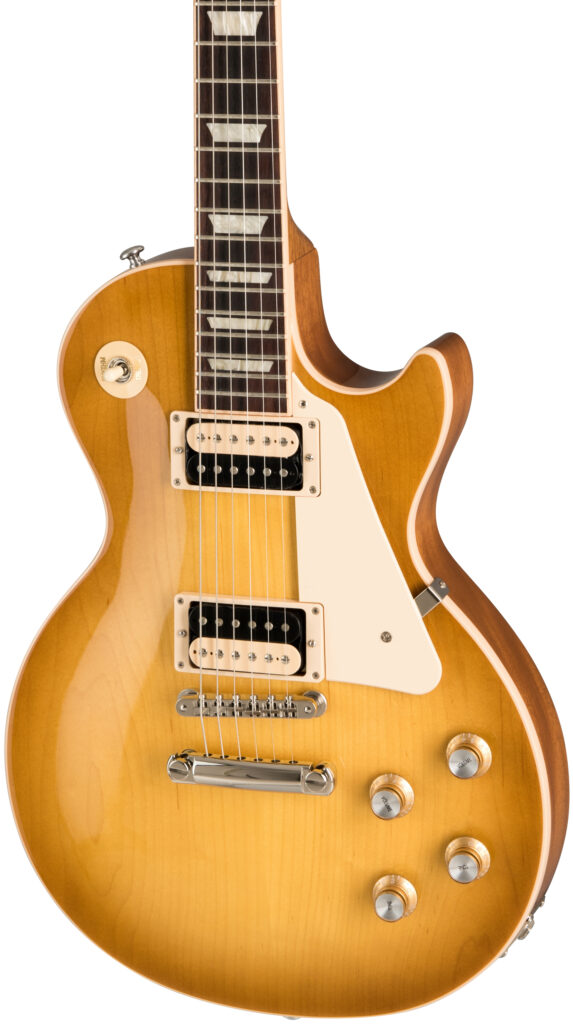
Gibson Les Paul Classic, Honeyburst
The Gibson Les Paul Classic is a more affordable alternative to the Kirk Hammett “Greeny” if you’re looking to own a new LP. Out of all the finish options, the Honeyburst-finished version is closest to “Greeny” in terms of looks.
This Les Paul guitar, part of the Modern Collection, blends classic LP aesthetics and tone with features designed for the contemporary guitarist. Whilst the Les Paul Classic is based on a ’60s rather than a ’50s model, it features advanced switching that makes it more versatile than a traditional LP.
Pulling up the neck tone pot reverses the polarity of the neck pickup for that “Greeny” middle position tone. Plus, you can also achieve crisp P-90-style single-coil tones and bypass the bridge pickup’s tone and volume circuit for a boost.
The body features 9-Hole Weight Relief, making it a lot more comfortable to use across an extended performance.
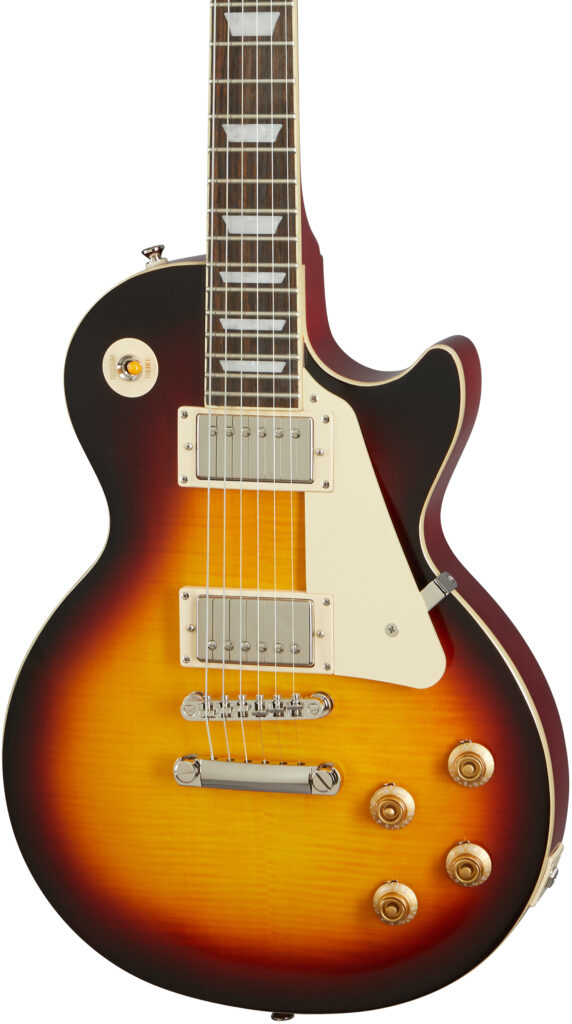
Epiphone 1959 Les Paul Standard, Aged Dark Burst
The Epiphone 1959 Les Paul Standard in Aged Dark Burst is an outstanding electric guitar for the price. The Gibson Custom Shop collaborated on the design of this limited-edition model, combining all the key features that make the 1959 Les Paul a holy grail guitar.
High-end appointments such as the hand-rolled 1959 neck profile and Gibson USA Burstbucker pickups belie this Epiphone 1959 Les Paul Standard’s keen price point.
Because the model is closely based on a 1959 Les Paul Standard, it’s a great option if you want that “Greeny”-esque ’50s feel and tone. However, you would need to modify the neck pickup to achieve that quintessential middle pickup tone.
You can do it yourself if you know how to use a soldering iron, otherwise, we recommend taking your guitar to an experienced tech.
Do you have a Les Paul or Les Paul-style guitar that you want to modify? Our in-house guitar technician Jamie is ready to tailor your guitar to your needs and get it playing its best. Click here to learn more about the guitar repair and maintenance services we offer at GAK or email us for a quote.
Jump Back To The Top
#7 – Jimi Hendrix’s 1968 Fender Stratocaster “Izabella” (£1.65 million)
At #7 on our list of the top 10 most expensive guitars sold at auction is Jimi Hendrix’s “Izabella”. Whilst Hendrix wielded many Stratocasters during his lifetime, “Izabella” is a special example. It’s arguably the Strat that Hendrix is most associated with, having been the guitar of choice for his iconic Woodstock performance.
Late Microsoft co-founder, Paul Allen, bought the Olympic White 1968 Fender Stratocaster for £1,650,000 in 2000. This hallowed Fender Strat now resides at the Museum of Pop Culture in Seattle.
An Inspiring Instrument
Jimi Hendrix was well-known for always having a guitar in his hands and constantly playing. His affinity and passion for the instrument helped make him a master of it.
Hendrix always held a particular fondness for the Stratocaster, but there was a particular one that stole his heart. He called this one “Izabella”. This guitar would eventually inspire Hendrix to write a song of the same name.
Standard Issue Specs
“Izabella” was a purchase from Manny’s Music in New York City, a landmark music store in the States. The 1968 Olympic White Strat features standard issue pickups and hardware, an alder body and a two-piece maple neck, with no “skunk stripe” and truss rod adjustment at the heel.
Its F-style neck plate bears the serial number 240981, aligning with the standard 1968 issue. The big Strat headstock with its Bob Perine-designed Fender logo and bold arced “Stratocaster” type are a key part of this guitar’s iconic look.
The Woodstock Guitar
Out of the numerous guitars that Hendrix played, smashed, or set on fire, Izabella was an exception. It was one that he treated with reverence. This instrument became his faithful companion, accompanying him on his culture-defining 1969 Woodstock performance.
Star Spangled Stratocaster
On that fateful day, Hendrix took “Izabella” on a sonic journey through his incendiary songs, including “Hear My Train a Comin’,” “Foxy Lady,” and “Fire.” His performance culminated in a transcendent rendition of “The Star-Spangled Banner,” a powerful anti-war statement that also showcased Hendrix’s extraordinary mastery over the instrument.
Izabella held the honour of being the last guitar Hendrix played with his original Jimi Hendrix Experience group, as well as the final guitar he ever played in concert, cementing its place in music history.
Jump Back To The Top
Alternatives to “Izabella”
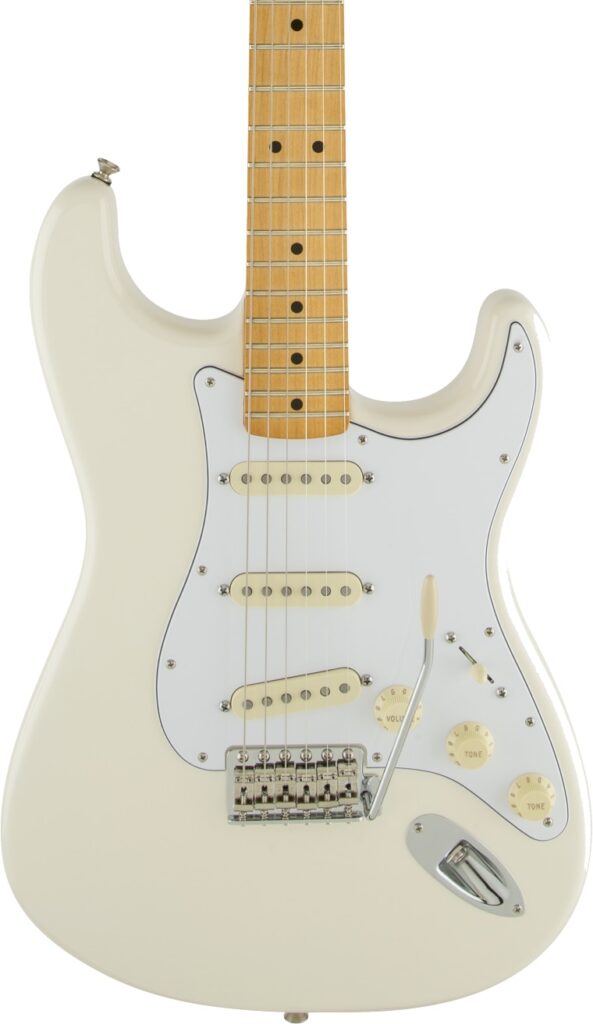
Fender Jimi Hendrix Stratocaster, Olympic White
The Fender Jimi Hendrix Stratocaster is a faithful ode to the electric guitar maestro and his approach to the instrument. This Mexican-made electric guitar is a superb option for Jimi Hendrix fans that doesn’t break the bank.
Because he was a left-handed guitarist, Hendrix would flip right-handed Strats upside so they’d be orientated for a leftie. This affected the way his Strats felt and sounded. The flipped headstock made the bass strings more taught (adding clarity and definition to chords) and the treble strings looser (making them easier to bend).
Plus, the bridge pickup was angled differently, with the bass strings closer to the bridge instead. This added brightness to the bottom strings whilst making the higher strings warmer.
Both of these crucial elements have been recreated with the Jimi Hendrix Stratocaster, allowing right-handed players to experience that distinctive Hendrix feel and tone without having to modify a left-handed Strat.
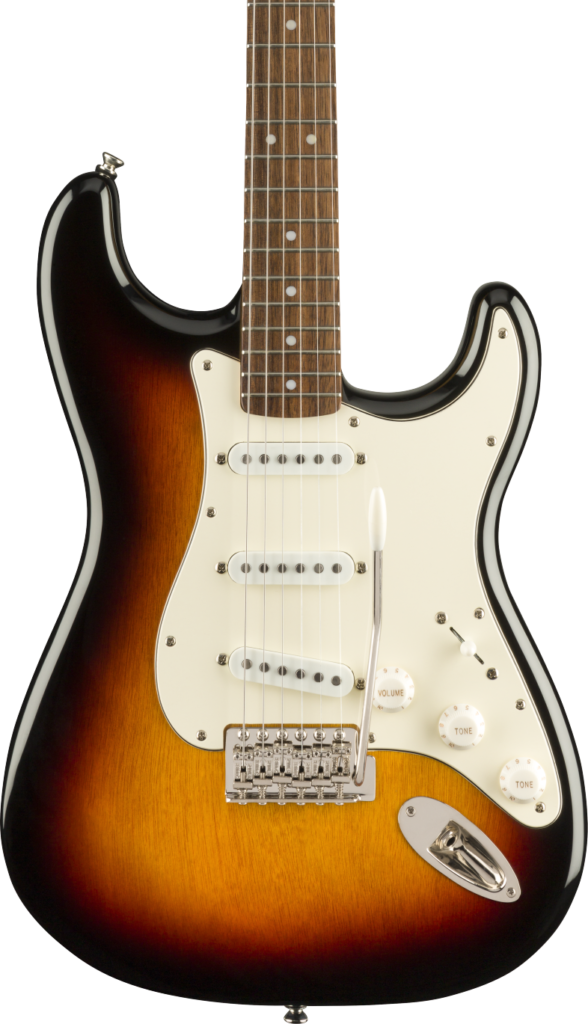
Squier Classic Vibe ’60s Stratocaster, 3-Colour Sunburst
The Squier Classic Vibe ’60s Stratocaster is an affordable option for guitarists that want to emulate Jimi Hendrix. This exceptional electric guitar, based on Strats from the same era as “Izabella”, delivers an unmistakable 1960s vibe.
Equipped with a trio of crisp and articulate Fender-designed single coils, a comfortable “C” neck profile and Narrow Tall frets, the Squier Classic Vibe ’60s Stratocaster gives you smooth playability and classic Strat tones on a budget.
Jump Back To The Top
#6 -John Lennon’s Gibson J-160E (£1.9 million)
Coming in at #6 on our list of the top 10 most expensive guitars sold at auction is John Lennon’s Gibson J-160E. The story behind this guitar is incredible. It lived lost and in obscurity for years before its owner, John McCaw, realised what he had.
After discovering that he owned one of John Lennon’s most important Beatles guitars and receiving permission from Yoko Ono to sell it, the McCaw put it up for auction.
The acoustic guitar that had been a faithful jamming companion to McCaw for years would sell for £1,900,000 to an anonymous buyer in November 2015, earning three times its estimate.
A Remarkable Journey
A vital piece of music history, John Lennon’s Gibson J-160E acoustic-electric guitar, was missing for more than four decades.
This guitar was one of two nearly identical 1962 Gibson J-160Es that Beatles manager Brian Epstein purchased for Lennon and George Harrison on September 10, 1962, at Rushworth’s Music House in Liverpool. The cost of each guitar would be around £3,000 today when adjusted for inflation.
Although Lennon didn’t use the guitar for a long period, the impact it left on popular music is immense. He used it to co-compose a collection of timeless Beatles classics like “I Saw Her Standing There,” “She Loves You,” and “I Want to Hold Your Hand,” alongside Paul McCartney.
Lost In The Ether
The Beatles’ long-time roadie, Mal Evans, was responsible for the guitar’s disappearance. He apparently left it behind after one of the Beatles’ legendary 1963 holiday concerts at the Finsbury Park Astoria Theater in London. Mal lamented this incident as the lowest point in his early Beatles career.
After four years shrouded in mystery, the guitar resurfaced in 1967 at a San Diego guitar shop called the Blue Guitar, a popular hub of the city’s burgeoning folk, rock and bluegrass scene.
Tommy Pressley, a then-21-year-old carpenter’s apprentice and bluegrass player who frequented the shop, bought the guitar for $175. In need of money a couple of years later, Pressley sold it to his childhood friend, John McCaw, for the same price.
50 Years in Obscurity
McCaw, who still works as a contractor in the San Diego area, kept the guitar for nearly five decades. He occasionally played it, although he admitted that it often stayed on his wall or in a closet. The guitar remains untouched since the day he bought it, with all the little dents, nicks, and dings intact.
A Treasure Uncovered
The guitar’s identity became clear in 2014. McCaw noticed a photo of George Harrison’s 1962 Gibson J160-E in a Guitar Aficionado magazine after a group guitar lesson at San Diego’s Sanctuary Art and Music Studio.
Recognizing the close similarity in the serial numbers, McCaw and studio owner Marc Intravaia contacted Beatles Gear author Andy Babiuk. Babiuk was able to authenticate McCaw’s guitar as the long-lost Lennon instrument.
Jump Back To The Top
Alternatives to a Gibson J-160E
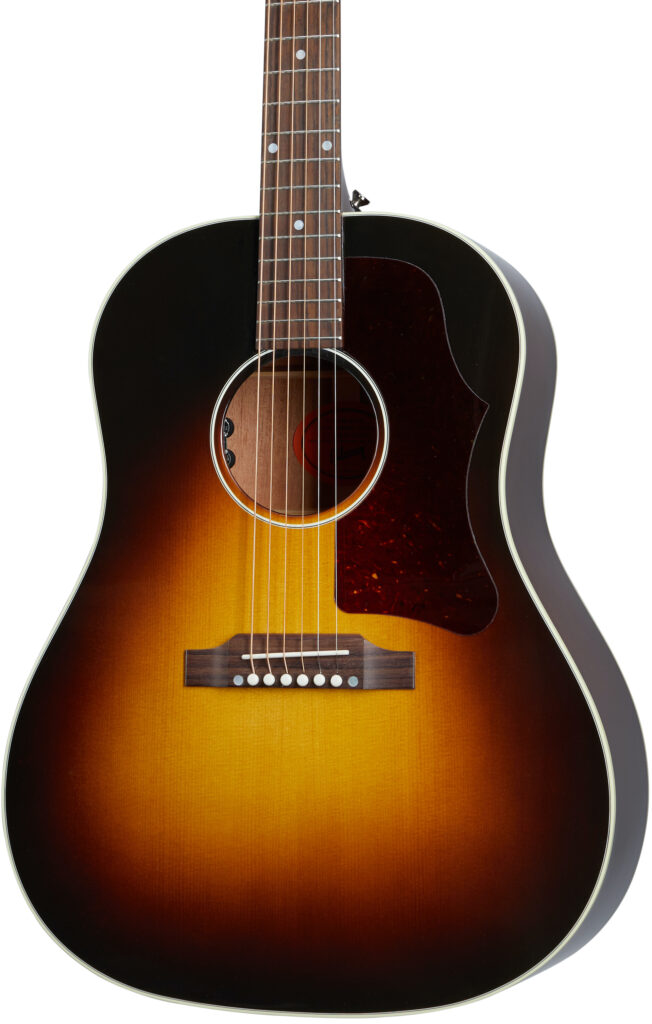
Gibson 50’s J-45 Original, Vintage Sunburst
The Gibson 50’s J-45 Original is one of the best modern options available if you want to emulate Lennon’s J-160E. The 50’s J-45 Original is also an electro-acoustic guitar with a dreadnought body shape. It also uses the same tonewoods, including mahogany back and sides, a sitka spruce top and a rosewood fretboard.
The Vintage Sunburst-finished model is the one for Lennon and Beatles fans, as it matches the original J-160E. The 50’s J-45 Original is an exceptional acoustic, boasting the renowned craftsmanship and inspiring tone that you’d expect from a genuine Gibson acoustic guitar.
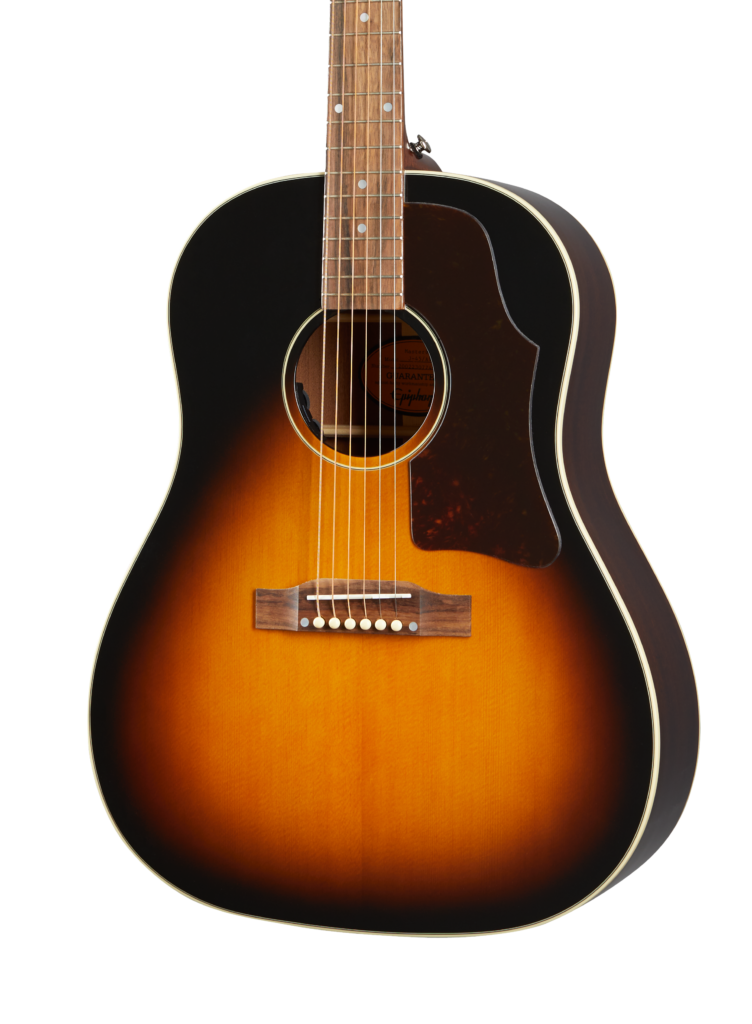
Epiphone Inspired by Gibson J-45, Aged Vintage Sunburst
The Epiphone Inspired by Gibson J-45 is another fantastic electro-acoustic guitar that delivers a similar spec to John Lennon’s Gibson J-160E at an affordable price point. This model is also available in Vintage Sunburst, akin to the one Lennon played on those timeless Beatles tracks.
Boasting mahogany back and sides, a solid sitka spruce top and premium Fishman electronics, the Epiphone Inspired by Gibson J-45 is an excellent songwriting and gigging companion.
Jump Back To The Top
#5 – Reach Out to Asia Fender Stratocaster (£2,232,000)
At #5 on our list of the top 10 most expensive guitars sold at auction is a guitar that previously held the top spot on this list, the star-studded Reach To Asia Fender Stratocaster.
The Reach Out to Asia Fender Stratocaster earned the title of the most expensive guitar ever sold in 2005, raking in £2,232,000 at an auction in Qatar. That’s a pretty good price for a Mexican Standard Stratocaster, considering this particular model only cost $350 at the time.
The proceeds were donated to Reach Out to Asia, a charitable organization formed in response to the devastating Boxing Day tsunami in 2004. This guitar’s unique value stems from both the cause it served and the music-royalty autographs it bears.
From best-selling songwriters such as Paul McCartney, Ray Davies and Sting, to trailblazing guitar virtuosos like Jeff Beck, Tony Iommi, Angus Young, Brian May, Jimmy Page, Ritchie Blackmore and David Gilmour, this guitar bears the signatures of some of the most influential artists in rock history.
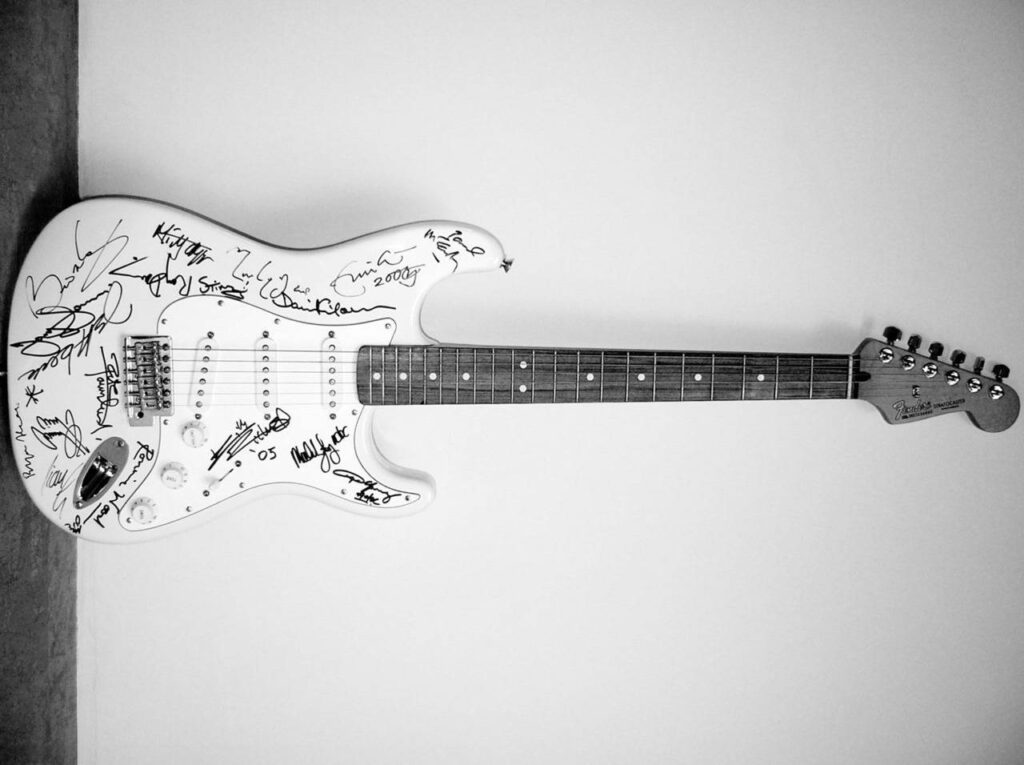
Jump Back To The Top
#4 – Eddie Van Halen’s “Hot For Teacher” Kramer (£3,167,343)
Coming in at #5 on our list of the top 10 most expensive guitars sold at auction is the hot-rodded “Hot For Teacher” guitar. This custom-made Kramer electric guitar, played in Van Halen’s “Hot for Teacher” music video, sold for a staggering £3,167,343 at Sotheby’s in New York in April 2023.
Reportedly, Van Halen gifted this unique guitar to the band’s retiring drum tech, Gregg Emerson, around 1990. It changed hands and eventually ended up at Neal’s Music in Huntington Beach, California before selling it to the pre-auction owner.
In addition to the guitar itself, the current owner also received a letter of provenance from Paul Unkert (the luthier that built the guitar), a signed photo from Eddie Van Halen, its original case, and even the straight jacket and white gloves worn by Van Halen in the “Hot For Teacher” music video.
Simple and Effective
In the pantheon of rock ‘n’ roll, few guitars can hold a candle to Eddie Van Halen’s “Hot For Teacher” Kramer. Crafted with a 22-fret, bolt-on maple neck, the guitar sports a singular Seymour Duncan humbucker, a sole volume knob, and a Floyd Rose bridge — a testament to Van Halen’s minimalist approach and penchant for divebombs.
Commissioned by EVH
Kramer luthier Paul “Unk” Unkert stands behind the creation of this milestone guitar. It bears the honour of being the first rear-loaded striped guitar that Unkert made for Eddie Van Halen.
Unkert, a key figure at Kramer during the early 1980s, is known for his detailed work, innovative designs, and close working relationships with Kramer’s artists.
Among his significant contributions are the yellow and black double neck for Van Halen, the parts for the 5150 guitar that Eddie assembled in Kramer’s workshop, and the “Hot For Teacher” guitar.
Weapon of Choice
This instrument’s birth traces back to late 1982, with delivery to Eddie following in January 1983. Carved from poplar wood, it became one of Eddie’s primary tools of the trade throughout 1983 and 1984.
Built by Unkert, the “Hot For Teacher” guitar was one of Van Halen’s main guitars in 1983 and 1984. Unkert was the main luther at the Kramer shop and created a few custom guitars for EVH during the 1980s. The “Hot For Teacher” model was his last project for the trailblazing guitarist.
This guitar’s famed red, white, and black stripe paint job originates from Eddie’s legendary 1970s “Frankenstrat”. This abstract design evolved alongside Van Halen’s musical journey, remaining consistent even after the release of their breakthrough album “1984”.
A Game Changing Endorsement
Kramer’s rise to prominence was accelerated by Eddie’s endorsement. According to Dennis Berardi, co-founder of Kramer Guitars, Eddie’s decision to collaborate with Kramer kicked off a partnership that turned Kramer into a major guitar brand.
Despite Eddie’s initial hesitance due to his preference for Floyd Rose double-locking systems, the company was able to win him over by securing a licence to use his bridge of choice. Before this, Kramer guitars were fitted with a locking system developed by the German company Rockinger.
EVH’s endorsement skyrocketed Kramer’s visibility and sales in the 1980s, making them one of the most popular high-performance guitar builders.
Jump Back To The Top
#3 – David Gilmour’s Black Strat (£3,285,000)
At #3 on our list of the top 10 most expensive guitars sold at auction is one of the most famous Stratocasters of all time – David Gilmour’s Black Strat.
This hallowed electric guitar holds a special place in rock history, having graced Pink Floyd albums like Dark Side of the Moon and timeless tracks like “Comfortably Numb”. Auctioned at Christie’s in June 2019, this guitar fetched an astronomical £3,285,000.
The proceeds from the Black Strat and the other guitar’s in the auction went to the environmental charity ClientEarth.
A Storied Acquisition
The Black Strat’s journey begins during Pink Floyd’s North American tour in 1970. During an early April visit to the legendary Manny’s Music on West 48th Street in New York, where Hendrix bought “Izabella,” Gilmour purchased a 1969 Stratocaster.
However, the guitar’s tenure with Gilmour was cut short when the band later discovered their van, containing all their gear, was stolen after playing two nights in New Orleans. The police were able to recover the van, but several items, including Gilmour’s new Stratocaster, were missing.
The incident led to the cancellation of the rest of the tour, and on the way back to Europe, Gilmour revisited Manny’s and acquired the now-iconic Black Strat.
An Instrumental Icon
The Black Strat was first showcased by Gilmour at the 1970 Bath Festival and eventually solidified its status as one of Gilmour’s main guitars. Over time, this instrument became integral to the distinctive sounds of some of the most celebrated albums in rock history.
Gilmour’s long-time technician, Phil Taylor, revealed in 2006 that the Black Strat was used on classic Pink Floyd albums Dark Side of the Moon, Wish You Were Here, Animals and The Wall as well as Pink Floyd’s performance at Pompeii.
Specifications and Modifications
Over the years, the Black Strat underwent numerous modifications, evolving from its original 1970 specs to a significantly different configuration. Originally, the guitar came with a late 60s maple neck, single coil pickups, and Fender F-style tuning machines.
By 2006, the guitar had been updated with a 1983 57 reissue maple neck, and Fender neck and middle pickups dated 1971. A Seymour Duncan custom wound SSL-1C bridge pickup and a 5-way pickup selector were also later added.
Today, the only original parts remaining are the pickup selector switch and possibly the bridge plate. According to David Gilmour, the colour is the one element of the guitar that he never changed.
Retirement and Re-emergence
In 1986, Gilmour replaced the Black Strat with three Candy Apple Red Stratocaster guitars with EMG pickups for touring and a cream Stratocaster for rehearsals, marking the beginning of the post-Roger Waters era.
The Black Strat was retired and displayed at the Hard Rock Cafe in Dallas, Texas. Unfortunately, it wasn’t placed in a glass case, resulting in significant damage and the theft of many of its parts.
Despite this setback, the guitar was returned to Gilmour in late 1990. The Black Strat eventually made its comeback at Pink Floyd’s momentous Live 8 performance.
Jump Back To The Top
Alternatives to the Black Strat
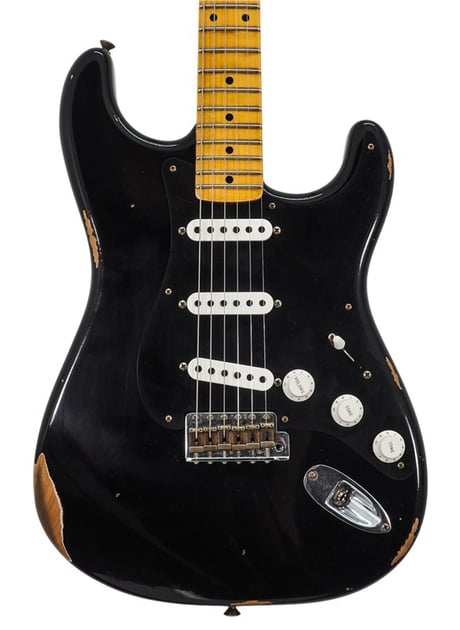
Fender Custom Shop 1957 Stratocaster Relic, Black
This Fender Custom Shop 1957 Stratocaster is heavily inspired by David Gilmour’s Black Strat. As well as nailing the Black Strat’s iconic look, this Fender Custom Shop model boasts period-correct appointments including a Soft “V” neck profile and nitrocellulose finish.
As with any Fender Custom Shop guitar, this is a heirloom-worthy instrument. From the hand-wound Fat ’50s single-coils to the top-tier tonewoods to the meticulous relic of the finish, every element of this guitar is truly world-class. A guitar of this calibre is sure to be a standout in any guitarist’s collection.
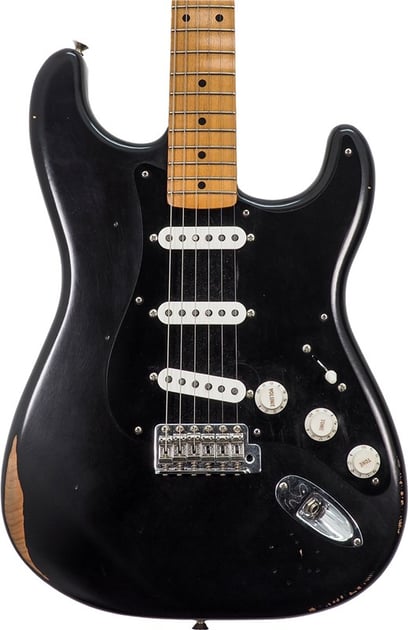
Fender Exclusive Vintera ’50s Tribute Stratocaster Road Worn, Black
Want to nail the Black Strat look, feel and tone but don’t have the budget for a Fender Custom Shop? This GAK-exclusive Fender Vintera is an excellent alternative, boasting a high-end spec that you’d usually find on pricier models.
We curated this Vintera Stratocaster’s jaw-dropping spec, outfitting it with Fat ’50s Custom Shop pickups and a nitrocellulose finish – just like the Fender Custom Shop model but much more affordable. Plus, the finish has been aged to emulate the worn-in wear of the Black Strat.
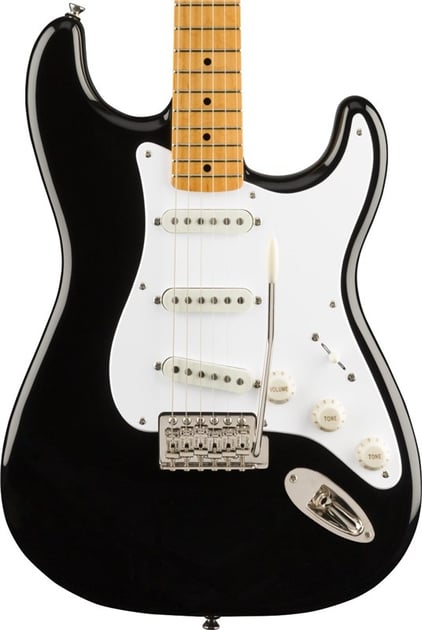
Squier Classic Vibe ’50s Stratocaster, Maple, Black
The most budget-friendly option for David Gilmour and Pink Floyd fans is the Squier Classic Vibe ’50s Stratocaster. It packs a tonne of vintage Strat vibe into a great playing and sounding electric guitar. The black-finished version looks like the Black Strat when David Gilmour originally purchased it.
If you want to bring the Classic Vibe ’50s Stratocaster closer to the Black Strat’s look, you’ll need to swap out the white pickguard for a black one (and get a few decades of playing wear into it).
Jump Back To The Top
#2 – Kurt Cobain’s Fender Mustang (£3.7 million)
Taking the #2 spot on our list of the top 10 most expensive guitars sold at auction is Kurt Cobain’s “Teen Spirit” Fender Mustang.
The guitar, a 1969 Fender Mustang Competition model flaunting a Lake Placid Blue Finish, fetched an astounding £3,700,000 at the Music Icons auction in New York, in May 2022. Initially estimated to draw between $600,000 and $800,000, the left-handed instrument far surpassed expectations.
The iconic Fender Mustang guitar that Kurt Cobain strummed in Nirvana’s unforgettable 1991 “Smells Like Teen Spirit” music video catapulted to the second highest-ranking position among the most expensive guitars ever auctioned.
The purchase was made by billionaire Jim Irsay, who added Cobain’s guitar to his impressive collection. Irsay previously set a world record in 2019 when he acquired David Gilmour’s legendary Black Strat.
Cobain’s Favourite Guitar
The Fender Mustang that Kurt Cobain used to pioneer the grunge revolution was a Lake Placid blue Competition model. Known for its racing stripe and matching painted headstock, it features an alder body, maple neck, and rosewood fretboard with dot markers.
Other appointments include 1960s Fender “F” tuners with white octagonal buttons and a pearloid 3-ply pickguard.
Pickups-wise, the “Teen Spirit” Mustang is equipped with a stock single-coil in the neck and a Seymour Duncan Hot Rails single-coil-sized humbucker at the bridge position. The strings are anchored by a reversed tailpiece and a non-original Gotoh Tune-O-Matic bridge, Cobain’s favourite bridge design.
On the “Teen Spirit” Mustang’s modified bridge, Cobain’s guitar tech Earnie Baliey said:
“I rebuilt the bridge section in a way that would be repeated on his [Cobain’s] In Utero era Sonic blue Mustangs. It involved replacing the bridge with a Tune-O-Matic style bridge, and flipping the tailpiece bar around backwards.”
“From there, several washers were added to the posts that connected the tailpiece to allow it to be tightened down against the plate that it rested on. This modification solved several problems. It disabled the tremolo system and, in the process, increased tuning stability.”
“Reversing the tailpiece itself allowed us to now re-string the guitar in a much easier process, stabilizing the tuning while changing the angle in which the string connected to the bridge which would reduce string breakage.”
“By tightening the tailpiece down against the plate, it also redirects the string resonance from being absorbed by the tremolo spring and to the body.”
As part of the auction, the guitar came housed in a non-original black coffin case, complete with one of Cobain’s straps, the original tremolo arm, and the original bridge pickup.
Battle Scars
Though the “Teen Spirit” Competition Mustang bears signs of aggressive usage, its CBS-era finish remains mostly intact. Notable wear includes a few marks on the front, significant damage on the lower ribs, and some finish worn off the back.
While it carries a few scars from wild shows, the guitar’s condition is fairly good. However, there are some wiring issues, particularly with the slide switches. As a result, only the bridge pickup currently functions.
The Grunge Revolution
The song ‘Teen Spirit’ by Nirvana represents a musical watershed moment, its echoes still resonating across generations. The iconic music video for “Smells Like Teen Spirit” put Cobain, Nirvana, and his Competition Mustang in the consciousness of every disenchanted nineties youth.
Kurt Cobain cherished the “Teen Spirit Mustang”. In fact, it was one of his favourite and most cherished guitars.
In a 1991 interview, Cobain said “But out of all of the guitars in the whole world, the Fender Mustang is my favourite” and “Lately, I’ve been using a Strat live, because I don’t want to ruin my Mustang yet.”
Live and Studio
Cobain wielded the “Teen Spirit” Mustang for several high-profile Nirvana performances, such as their 1991 show at the Tree Club in Dallas. At this show, the Mustang met a mixing board in an act of frustration related to the onstage sound.
The “Teen Spirit” Mustang was with Cobain during the recording sessions for Nevermind and at the album’s release show.
This Mustang also played a role in the 1992 In Utero demo sessions in Seattle and the album’s tracking in Minnesota, as confirmed by producer Steve Albini and Cobain’s guitar tech, Earnie Bailey.
Jump Back To The Top
Alternatives to the “Teen Spirit” Mustang
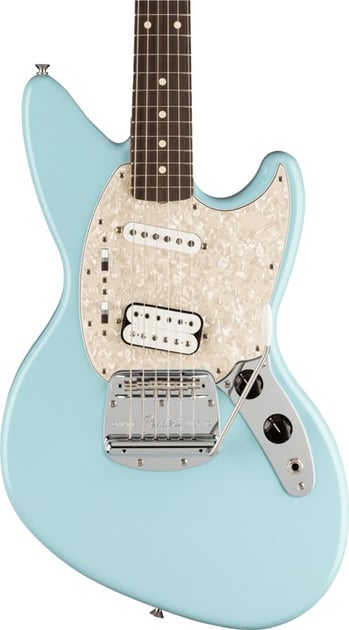
Fender Artist Series Kurt Cobain Jag-Stang, Sonic Blue
The Fender Artist Series Kurt Cobain Jag-Stang is a short-scale, humbucker-equipped electric guitar with an offset body shape. Like Kurt Cobain’s Competition Mustang, this Jag-Stang features an angled bridge humbucker that’s perfect for aggressive grunge tones.
Kurt Cobain collaborated with the Fender Custom Shop to create the Jag-Stang in 1993. It combines elements of Cobain’s two favourite Fender guitars – the Jazzmaster and the Mustang.
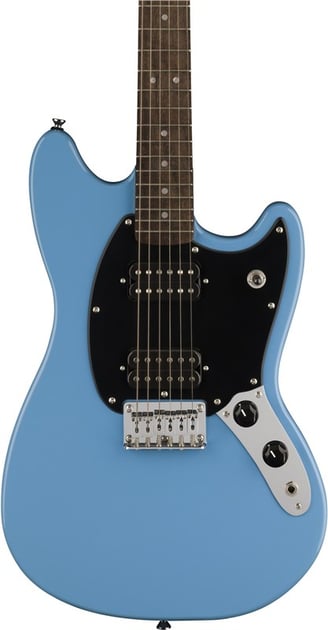
Squier Sonic Mustang HH, California Blue
The Squier Sonic Mustang, part of Squier’s affordable Sonic Series, is a superb humbucker-equipped offset guitar. It’s a fantastic choice for beginner and experienced players alike who want to emulate Kurt Cobain’s roaring tone and grunge aesthetic on a budget.
Jump Back To The Top
#1 – Kurt Cobain’s 1959 Martin D-18E (£4.8 million)
Kurt Cobain’s 1959 Martin D-18E, played during Nirvana’s MTV Unplugged session in 1993, became the most expensive guitar sold at auction in June 2020. It sold for a record-breaking £4,858,890 at a Julian’s Auctions sale.
This guitar, associated with Cobain’s hauntingly beautiful and raw performance, was sold with its original hard-shell case decorated by Cobain himself. It was purchased by Røde, the company behind the best-selling NT1-A microphone, founder Peter Freedman.
Unappreciated In Its Time
The Martin D-18E acoustic guitar holds a fascinating place in guitar history. Produced between 1958 and 1959, this model was Martin’s maiden attempt at creating an electric acoustic guitar. It’s essentially a Martin D-18 equipped with DeArmond Dynasonic pickups and a dual-tone knob system.
The D-18E faced severe backlash from acoustic guitarists of the time, which lead to poor sales. Only 302 D-18E guitars were manufactured, with Cobain’s being the seventh made.
A Priceless Purchase
In 1993, Nirvana’s frontman, Kurt Cobain, procured his Martin D-18E for a sum of $5,000 from Voltage Guitars in Los Angeles.
Cobain, not an avid collector, purchased it unaware of its rarity, drawn to the oddity of the instrument and hoping its sound would match its aesthetics. Initial modifications were made to adapt the instrument for left-handed playing.
Voltage Guitars recut the nut whilst John Saba filled in the bridge and routed a new slot for the saddle. This allowed the Cobain’s D-18E to be set up for left-handed playing.
In the Hands of Cobain
Cobain first publicly wielded the Martin D-18E at The Rock Against Rape benefit in Hollywood on September 8, 1993. He was not happy with the tone of the stock DeArmond pickups.
According to Cobain’s tech Earnie Bailey, this is because they were designed for use with nickel strings rather than the bronze ones Cobain was using. A Bartolini 3AV soundhole pickup was installed to combat this Cobain discovered this pickup through R.E.M. guitarist Peter Buck.
The guitar’s most iconic appearance was during Nirvana’s legendary MTV Unplugged In New York performance. Despite the acoustic nature of the show, Cobain insisted on plugging his D-18E into his Electro-Harmonix Small Clone chorus pedal, Boss DS-2 distortion pedal and Fender Twin Reverb amplifier.
After much pushback from the MTV Unplugged producers, they allowed Kurt to use his setup. The valves were swapped in Cobian’s Fender Twin Reverb to make its tone as clean as possible. The amp was placed in front of Cobain and covered to make it look like a standard floor wedge.
Unplugged and Beyond
Following the iconic MTV Unplugged performance, Cobain continued to play the Martin D-18E for subsequent shows on the In Utero tour. The guitar underwent more modifications, with Gotoh tuners replacing the original Grovers.
The last confirmed sighting of Cobain with the guitar was on February 27, 1994, in Ljubljana, Slovenia. This was Nirvana’s second-to-last gig before Cobain’s death.
Jump Back To The Top
Alternatives to the Martin D-18E
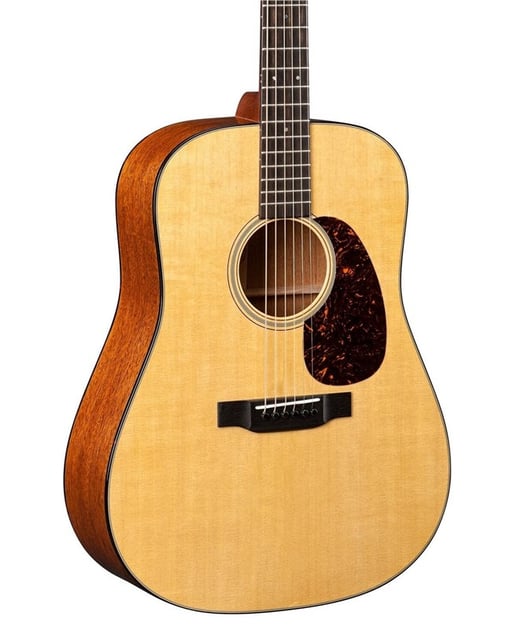
Martin D-18 Dreadnought Acoustic
A genuine Martin D-18 is the best option if you’re looking to emulate Cobain’s “Unplugged” D-18E. Although you could search for a vintage D-18E, they are incredibly rare and expensive when they do appear.
This Martin D-18 is fully acoustic, meaning it doesn’t come fitted with onboard electronics like the D-18E. However, a high-quality soundhole pickup such as the DiMarzio DP234 The Black Angel can be installed without needing to modify or drill your guitar.
The D-18 is up there with the Stratocaster and Les Paul when it comes to iconic guitar models. If you’re simply looking for a truly world-class acoustic guitar, the Martin D-18 is an excellent choice.
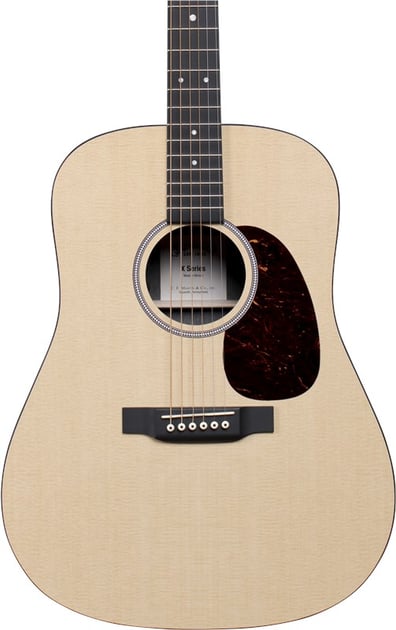
Martin D-X1E Dreadnought Electro Acoustic, Spruce Top
The Martin DX-1E Dreadnought Electro Acoustic is a fantastic acoustic guitar that delivers inviting playability and an inspiring tone at a keen price point.
Like the “Unplugged” D-18E, the Martin DX-1E is a dreadnought-sized electro-acoustic guitar. Plus, it’s a lot more affordable than a D-18 and doesn’t need to have electronics fitted – it’s ready to plug in and play.
Jump Back To The Top
Final Remarks
In the annals of rock ‘n’ roll history, few items capture our imagination as vividly as the guitars of our idols. This impressive roster, from David Gilmour’s Black Strat to Jerry Garcia’s Wolf, serves as a testament to the immense talent and influence of these legendary artists.
These instruments in this list are more than mere pieces of wood, metal, and plastic. They are extensions of the musicians themselves, imbued with the echoes of every chord and solo played.
Through the likes of Kurt Cobain’s Martin D-18E, played during Nirvana’s pivotal MTV Unplugged performance, or Jimi Hendrix’s Izabella, heard at the historic Woodstock Festival, we’ve glimpsed into the heart of music history.
These guitars represent an intersection of music, history, and commerce – tangible proof of the lasting impact these musicians have had on our cultural landscape.
They bear the legacy of their previous owners and will continue to inspire many future generations of guitarists to come. So, as we sign off on this journey, let’s salute the enduring power of music and the iconic guitars that helped shape it.